 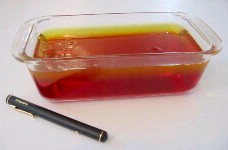  With a bowl of JELLO and a laser pointer, you can see for yourself how light changes direction, or refracts, when it goes from one medium to another. You can also see total internal reflection.
With a bowl of JELLO and a laser pointer, you can see for yourself how light changes direction, or refracts, when it goes from one medium to another. You can also see total internal reflection.You'll need a clear bowl, some red and yellow Jello, and a red laser pointer. We made the red Jello first in the bottom of the bowl. When it was solid, we made a yellow batch on top of it. Red Jello absorbs all colours of light that pass through it except red, allowing this colour to pass through. We found that the yellow Jello also passes red light quite well ... that's why we used it too. The laser beam is easily visible in both types of Jello. 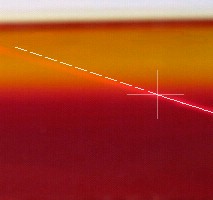 When light passes from one medium to another, it will refract, or bend, by an amount that depends on how different the optical densities of the media are. The optical density of each medium is its index of refraction.
When light passes from one medium to another, it will refract, or bend, by an amount that depends on how different the optical densities of the media are. The optical density of each medium is its index of refraction.We had expected the indices of refraction for red and yellow Jello to be nearly identical, and in fact they were. However, the index for yellow Jello is apparently very slightly less than that for the red, as we observed a slight bending of the light ray away from the projected path of the light, as you can see in the photo at the left. There is an even greater refraction that occurs when the light leaves the Jello to enter the air, but we weren't able to observe the beam in air ... more on that later! 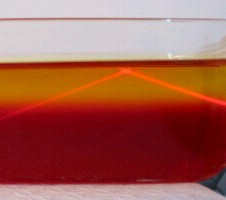 At some angle, light trying to leave the Jello will refract so much that all of it follows a path back into the Jello. The angle at which this happens is called the critical angle, and was easy to observe and measure when the light was leaving the yellow Jello into air, as shown in the photo at the left.
At some angle, light trying to leave the Jello will refract so much that all of it follows a path back into the Jello. The angle at which this happens is called the critical angle, and was easy to observe and measure when the light was leaving the yellow Jello into air, as shown in the photo at the left.
Because the indices of refraction for red and yellow Jello are so similar, we couldn't observe the critical angle for light passing from red to yellow Jello. We tried experimenting with other colours having red in them, but couldn't find another colour of Jello that would show the beam of red laser light. In order for light to be 'visible', it must hit something. As light passes through air, it does interact with the air molecules, but not enough to produce a visible path, as the air molecules are too far apart. In a solid like Jello, however, the light hits a lot of Jello molecules because they're packed together more densely, and some of the light that is not absorbed (in this case, red) will scatter and be visible to your eye. There are various methods you can use to make light beams visible in air, and most involve introducing small particles into the path of the beam for the light to scatter from. The simplest method is to use a misting spray bottle to place water droplets in the air. You'll be able to see the beam clearly. Unfortunately the beam won't show up in a photo. In order to demonstrate this method for seeing the beam in air, we experimented with other means, looking for ones which would photograph. We found that flour, shaken through a seive, and PAM spray (for coating pans before cooking) both produced a visible beam that would also show up in photos (see below). 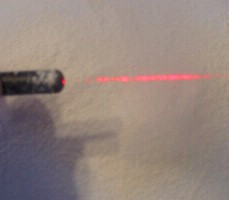 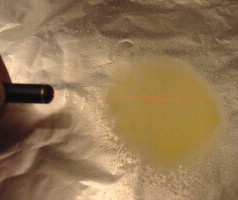 Although we didn't try it, you might combine a water mist with the Jello to be able to see the beam refracting as it passes from Jello into air. You might want to also experiment with mirrors, lenses, or prisms to make other reflection and refraction properties visible. 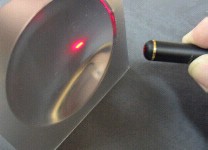 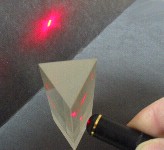 |